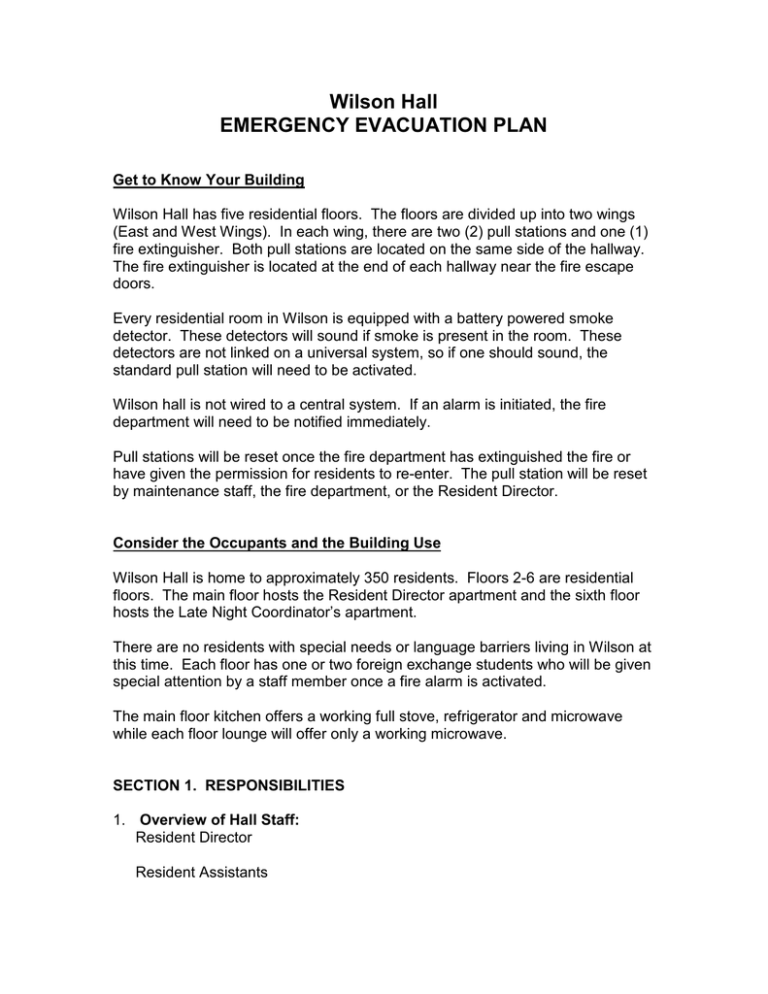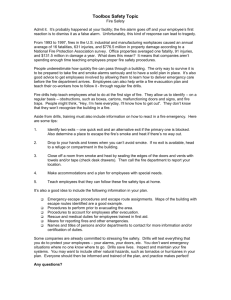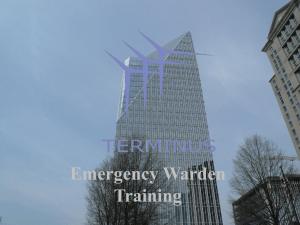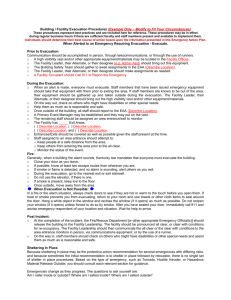Wilson Hall EMERGENCY EVACUATION PLAN
advertisement

Wilson Hall EMERGENCY EVACUATION PLAN Get to Know Your Building Wilson Hall has five residential floors. The floors are divided up into two wings (East and West Wings). In each wing, there are two (2) pull stations and one (1) fire extinguisher. Both pull stations are located on the same side of the hallway. The fire extinguisher is located at the end of each hallway near the fire escape doors. Every residential room in Wilson is equipped with a battery powered smoke detector. These detectors will sound if smoke is present in the room. These detectors are not linked on a universal system, so if one should sound, the standard pull station will need to be activated. Wilson hall is not wired to a central system. If an alarm is initiated, the fire department will need to be notified immediately. Pull stations will be reset once the fire department has extinguished the fire or have given the permission for residents to re-enter. The pull station will be reset by maintenance staff, the fire department, or the Resident Director. Consider the Occupants and the Building Use Wilson Hall is home to approximately 350 residents. Floors 2-6 are residential floors. The main floor hosts the Resident Director apartment and the sixth floor hosts the Late Night Coordinator’s apartment. There are no residents with special needs or language barriers living in Wilson at this time. Each floor has one or two foreign exchange students who will be given special attention by a staff member once a fire alarm is activated. The main floor kitchen offers a working full stove, refrigerator and microwave while each floor lounge will offer only a working microwave. SECTION 1. RESPONSIBILITIES 1. Overview of Hall Staff: Resident Director Resident Assistants 2. Plan Update: The Wilson Hall Evacuation plan will be reviewed at least once per quarter. Staff information will be updated. Relevant student information will be updated (assistance in evacuation needs). 3. Resident Responsibility: Residents are required to evacuate the building through the use of the fire escapes. Residents are not to use the main stairwell due to poor ventilation systems. Residents are required to activate a pull station if a fire is evident. They will then need to inform a staff member once they have evacuated the building. THERE ARE CURRENTLY NO STUDENTS IN WILSON KNOWN TO NEED ASSISTANCE IN EVACUATING WILSON. (9/10/10) SECTION 2. FIRE REPORTING A. Wilson Hall is not linked to an Automatic Alert System. 1. Wilson Hall has several pull stations located throughout the building. Should a fire occur, residents are taught to pull a station and evacuate. 2. Staff members are to look for activated pull stations as they leave the building. They will then report that information to the fire department. 3. A Wilson Hall Staff Member will call the Fire Department from the emergency phone located on either the front of Wilson Hall or Callahan Hall. 4. The Wilson Hall Resident Director or Staff Point Person will assist the Fire Department in assessing the situation. This person will have a good understanding of the hall and its fire system. 5. The Wilson Hall Resident Director will be the primary person to call for response. If the RD is not available, the SRA will be the Staff Point Person in the event of an emergency. Should they be unavailable the staff member with the most experience will become the Point Person. B. Information to provide to the Fire Department. 1. Correct building address and cross streets: 1351 Adams Ave. Corner Adams of 14th and 2. Floor number (Where the fire is located) 3. Location (room number or wing) within the building (if known)* 4. Nature of fire or emergency 5. Name and phone number of person making call 6. What (if anything) is being done to fight the fire Important: Stay on the line until told to hang up! SECTION 3. EVACUATION In the event of a fire alarm the building will be evacuated by means of the fire escapes on the east and west sides of the building. Assuming these responsibilities can be completed safely the staff will have the following responsibilities: All staff will knock on doors as they pass them and let residents know they should be exiting the building through the fire escapes. The Resident Director will proceed to the main building lobby to verify the roster, fire panel key, and master key are being taken by a staff member then exit the building to the parking lot to meet up with Emergency Response Units and the Wilson Staff. In the event of the Resident Director not being present, the first RA to reach the meeting location (gravel parking lot across Adams Ave from front entrance), will enter front door of building (if safe) and grab the hall roster, Building Master key, hall duty phone, radio, and Fire Evacuation Plan. Then this Resident Assistant will exit the front of building and wait for Fire personnel or Residence Life professional staff to respond and give further instructions. SECTION 4. FIRE CONTROL PROCEDURES Describe who, when, where, and how assigned individuals will: 1. Call 9-1-1 (Wilson Point Person/Duty RA) 2. Notify the Public Safety, RMF (Facilities) supervisor and/or the Fire Prevention & Protection specialist. (University Public Safety) 3. Close doors if possible on your way out of the building. (All Staff) 4. Meet arriving firefighters at door(s), outside. (RD or Point Person) 5. Shut down utilities (if requested by firefighters). (Maintenance) 6. Secure resident room areas if possible... Safety First! (All Staff) 7. Inform residents of meeting areas outside of the building. (All Staff) SECTION 5. POST FIRE OPERATIONS After the fire is out and the emergency is over, the Hall staff is responsible for security and working with the Building Inspector or Point Person to determine when the building can be safely re-occupied. The RMF Supervisor establishes procedures for returning the building to operational condition and will coordinate actions: 1. 2. 3. 4. When local authorities allow reoccupation of building. Security of any damaged area. Return of the building and fire protection systems to normal operation. Debris removal. SECTION 6. BUILDING EQUIPMENT TESTING A. The following is a list of systems in a typical building. Please list all of the information referred to in this section for each system in your building. 1. 2. 3. 4. 5. 6. 7. 8. Automatic sprinkler Standpipe systems Fire pumps Emergency generator Pressure regulating valves Air handling systems Elevator systems (Include procedures for fire service operations) Fire alarm systems a. Voice alarm b. Smoke detector c. Heat detector d. Sprinkler water-flow switch e. Manual pull stations f. Central station monitor connection g. Hearing impaired fire/life safety devices B. It is the Hall/COOP staff’s responsibility to become familiar with all of the emergency systems in the building. A copy of all FP&P systems’ manuals should be placed in an emergency box or location which is accessible to Fire Department personnel. C. This section should describe the test sequence, required measurements, and record-keeping method for the periodic testing of the building’s FP&P equipment. Information is available from the UHDS Fire Prevention Officer. D. Keep in mind the requirement to test fire systems quarterly and establish the frequency of the tests. Describe procedures to shut down and start up the systems. Include any cautions or warnings vital to protecting the equipment from damage of disruption to itself or other interconnected systems. (This situation might occur, for example, if certain steps were taken out of order, etc.) E. Identify who will conduct the tests, and list the devices required. Indicate who is responsible for assuring tests are properly conducted. Comments: It is essential to have building FP&P systems inspected and tested periodically as per regulating codes. SECTION 7. PROVIDE A LIST OF AREAS THAT CONTAIN ITEMS OF HIGH VALUE susceptible to water damage, susceptible materials, assembly rooms, and rooms containing above-average amounts of combustible materials or hazardous materials The Wilson Hall grill is located in the trash room. It has a propane tank attached to it. There is a checkout and check-in sheet attached to the grill. It specifies the procedures staff must go through when checking the grill out for use and when returning it to the trash room. It also has a place for staff to initial, so we can keep track of who uses the grill last. Comments: Because various materials and equipment react differently to water, smoke, and combustion, it is of great importance that the RMF staff be made aware of such items in order to modify the life/safety systems accordingly. SECTION 8. LIST THE UTILITY SHUT-OFF VALVE LOCATIONS, INCLUDING WATER, power, gas, sprinkler system, main, and sectional values. Indicate the location of these valves and any unusual operating techniques. List all locked-out floors and the location (accessible to the Fire Department) of the master keys for them. Several sets of keys should be made available for Fire Department use. Comments: The listing of valves and main power switches is necessary to enable emergency crews to quickly determine the exact location and any peculiarities that may pertain to them. Reduced floor plans showing locations would be helpful. SECTION 9. THE FOLLOWING NAMES AND TELEPHONE NUMBERS SHOULD BE LISTED IN THIS PLAN AS WELL AS POSTED ON THE CONTROL ROOM WALL. A. Building Owner (University Housing & Dining Services) B. Facilities Manager (RMF Maintenance Supervisor) C. UHDS Fire Prevention Officer D. Service Companies: 1. 2. Elevator (OSU Facilities Services Elevator Mechanics) Alarm systems (include monitoring company) 3. 4. 5. 6. 7. E. Sprinkler systems (include monitoring company) Air systems Communications Glass contractor General contractor Insurance carrier for the building Comments: Keeping this information current and readily accessible is necessary so that emergency repairs can be expedited. EMERGENCY PROCEDURES FOR HALL/COOP STAFF Always assume an alarm is real. Read and learn the Employee Emergency Procedures Manual, and keep it accessible. Participate in all drills and training. Know at least two safe exit routes prior to an emergency. Take time to familiarize yourself with all fire exits prior to an emergency. IF YOU ARE THE ONE TO DISCOVER FIRE OR SMOKE: 1. 2. 3. 4. 5. 6. 7. 8. 9. Contain the fire, if possible, by closing all doors and windows. Alert and remove people in immediate danger. Use the manual pull station located by each stairwell if the alarm has not sounded. Notify the Fire Department (9-1-1). Begin evacuation procedures – Do NOT use elevators. Stay calm; walk. Once you leave the area Do NOT return. Safety First! Listen for and follow directions of Fire Department personnel or building staff. Once in the stairwells, stay to the right, holding the handrail; and allow others to enter the stairwell. Do NOT block traffic. If you are in an enclosed office or room when an alarm has sounded: FIRST FEEL THE DOOR: A. IF THE DOOR IS WARM: 1. Do NOT open it. 2. Call the Fire Department (9-1-1) or Public Safety at 541-737-7000, notifying them of your exact location. 3. Place a cloth along the bottom of the door to keep smoke out. 4. Close as many doors as possible between you and the fire or smoke. 5. Place a sign on the window for the firefighters to see. 6. Stay calm and wait to be rescued; you will be found. 7. Do NOT break the window. B. IF THE DOOR IS COOL: 1. Open it cautiously, and be prepared to close it if there is excessive smoke. 2. Proceed to the exit. Stay low, or crawl and keep your eyes closed as much as possible if smoke is present. If you or anyone in your office will need assistance evacuating because of sight or hearing impairment, disability, or restricted mobility, notify your RA so they can assign two “assistant monitors” to assist with the evacuation. Remember to be prepared, get involved, and – if necessary – be willing to help. IF YOU ARE UNABLE TO USE THE STAIRS BUT CAN MOVE TO THE EXIT: Move to the exit stairwell. If it is free of smoke, wait inside for Fire Department assistance. If the exit is not free of smoke, return to an enclosed area, such as your apartment; and use fire survival skills as described below. If you are waiting in the stairwell, please keep against the wall. Move down a few steps if the landing is crowded so that you don’t block the path of others moving downward. IF YOU ARE UNABLE TO LEAVE YOUR AREA: Physical handicaps or fire conditions in the exit may prevent you from evacuating. In this instance, take action to block off openings which may allow smoke to enter your unit. Use towels or clothing to block openings around doors or vents where smoke might enter. Put a wet cloth over your mouth and nose. Place a signal in the window. The signal can be anything that will call attention to your location. For instance, tie the curtains in a knot. Place something in the window that would appear unusual, and draw attention to your location. If smoke or fire enters your unit, call 9-1-1 or 541-737-7000 to report your location. Stay low to the floor to breathe the best air. It is advisable not to open or break windows. Often smoke from the outside of the building can enter through open windows. Breaking windows will put you at great risk to smoke entering from the outside and will hamper rescue efforts below. If you use a wheelchair for mobility, the best practice is to have two persons who can assist you. When an alarm sounds, and after the traffic in the stairway has cleared, the two assistants should wait with you in the stairwell, attempting not to block the exit way. If conditions in the stairwell become threatening, the assistants should carry you to a floor below the fire. If you do not have assistants to help you, your best practice may be to wait in your apartment or office to close yourself off from smoke. If the conditions in your apartment or office are threatening, you should attempt to get into the exit stairwell and wait for the Fire Department to assist you. Hall staff must attempt to account for everyone in the pre-arranged meeting areas. If those individuals requiring evacuation assistance were missed or were not found do not return to the building, inform the Fire Department. For questions about fire evacuation or fire prevention, contact your Fire Department. EXPLOSION An explosion can occur from a leaking as line, gas stove, leaking propane tank, or an explosive device. It may be necessary to partially or fully evacuate the building. Move patients to a safe area and provide care. Call the 9-1-1 or 541-737-7000 immediately and initiate the emergency call list. If the explosion occurs from an explosive device, establish security of the area until law enforcement arrives. Most explosions will cause substantial damage to utilities which will then need to be turned off at the main controls. All utilities, gas, electricity, water, and fuel should be checked for damage before returning residents to the facility. Telephone Number ELECTIRC COMPANY GAS COMPANY WATER COMPANY SPRINKLER SYSTEM Location of Master Controls ALARM SYSTEM NOTE: It may be helpful to include photographs as well as written descriptions of the master control locations in this manual. BASIC GUIDE FOR FIRE SAFETY CHECKS 1. SMOKING • • Smoking policy is posted in the facility. Regulations are enforced (designated outside areas). 2. COMBUSTIBLE STORAGE • • • • Material is stored “neatly”. Material is NOT stored in boiler room, mechanical rooms, or electrical equipment rooms. Waste and trash are removed regularly. All storage items located at least 18” below all sprinkler heads. 3. OXYGEN • • • • • Cylinders (both full and empty) are chained and not in direct sunlight when stored outside. When in use, cylinders are secure on a stable dolly. Caps are on cylinders when not in use. “No Smoking” signs are on all doors where oxygen is stored or in use. Medical gases shall be stored in areas dedicated to the storage of such gases without other storage or uses. When containers of medical gases in quantities greater than the permit amount are located inside buildings, they shall be in a one-hour exterior room, a one-hour interior room or a gas cabinet in accordance with Uniform Fire Code, Sections 7404.2.1.2, 7404.2.1.3 or 7404.2.1.4. 4. ELECTRICIAL • • • • • • Extension cords are not used as “permanent” wiring for equipment and ARE NOT USED IN ADA ROOMS No spliced or frayed cords are used within the facility for any reason. “Ganged”, daisy chained, or multiple connections for cords are not in use. Proper sized bulbs are used. Circuits are not overloaded (panel/wiring excessively warm to touch). Emergency power source is operable. • Adequate clearance (35” minimum) is maintained for access to electric panels. 5. SPRINKLER AND ALARM • • • • • • • • • Alarm panel indicates “normal” or does not indicate systems is in “trouble”. Fire alarm system is regularly tested and maintained. Manual fire pull stations are available in the path of egress and are not hidden from view. Smoke detectors are regularly tested and maintained. Fire sprinkler inlet and control valves are visible and accessible (36” minimum), not obstructed by storage or other items. No storage located within 18” of sprinkler head on a plane across the entire room. Spare sprinkler heads and sprinkler head wrench are available. Portable fire extinguishers are fully charged and serviced annually. Sprinkler systems regularly tested and maintained. 6. CORRIDORS/COMPARTMENTATION • • • • • • Corridors/exit ways are free of obstructions. Exit doors are plainly marked, are not stuck, locked, or blocked to prevent egress. Smoke/fire doors operate properly and are not propped open. Hazardous area doors are kept closed and not wedged or prohibited from closing. Sick rooms (COOPs) and all other rooms opening into the corridors latch when closed. Evacuation routes are posted throughout the facility. 7. EQUIPMENT • • • • • • Range hood and filters are free of grease. Range hood suppression system is serviced every six moths. Air conditioning and heating system filters are clean. Dryer lint screens are cleaned frequently, at least once each shift. Areas behind dryers (motors, belts, and pulleys) should be thoroughly cleaned as needed. Dryer lint screens are free of holes. 8. FLAMMABLE LIQUIDS • • • Stored in proper containers and limited amounts. “NO SMOKING” signs posted. Proper ventilation is provided. • • Located proper distance from open flame. Acids and chemicals safely stored.



